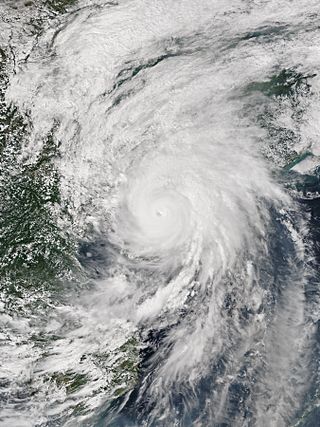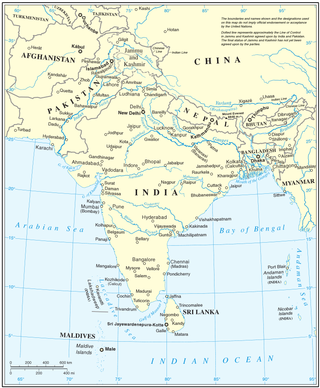
Severe Tropical Storm Kammuri, known in the Philippines as Tropical Storm Lagalag, killed hundreds of people in the wake of a deadly flood season in China. The system developed from a large monsoonal system that persisted toward the end of July 2002 near the Philippines. On August 2, a tropical depression formed off the northwest coast of Luzon and moved west-northwestward. Late on August 3, it intensified into Tropical Storm Kammuri off the coast of Hong Kong. A weakening ridge turned the storm northward toward the coast of China. The storm made landfall with late on August 4, after reaching peak winds of 100 km/h (65 mph). The system dissipated over the mountainous coastline of eastern China and merged with a cold front on August 7.

Severe Tropical Storm Bilis, known in the Philippines as Tropical Storm Florita, was a weak tropical cyclone in July 2006 that caused catastrophic damage to areas of the Philippines, Taiwan, and southeastern China. The word Bilis, submitted by the Philippines, means 'speed' or 'swiftness' in Tagalog.

The 2008 South China floods began on 26 May 2008. Four rounds of torrential rains with landslides and flooding lasted for 20 days and affected fifteen provinces in Eastern and Southern China.

Typhoon Hagupit, known in the Philippines as Typhoon Nina, was a powerful cyclone that caused widespread destruction along its path in September 2008. The 21st depression, 14 tropical storm and 10th typhoon of the 2008 Pacific typhoon season, Hagupit developed from a tropical wave located a couple hundred miles east of the Marshall Islands on September 14. Moving generally north-west westwards towards the Philippines, the depression gradually intensified into a tropical storm the following day, and then into became a typhoon on September 22 off the northern coast of Luzon. Located within an environment conducive for strengthening, Hagupit rapidly strengthened to attain 10-min sustained winds of 165 kilometres per hour and 1-min sustained winds of 230 kilometres per hour. After making landfall in Guangdong province in China at peak intensity on September 23, Hagupit rapidly weakened over rugged terrain and dissipated on the 25th.

The 2010 China floods began in early May 2010. Three hundred and ninety-two people died, and a further 232 people were reported missing as of June 30, 2010, including 57 people in a landslide in Guizhou. Fifty-three of the deaths occurred from the flooding and landslides between May 31 and June 3, and 266 deaths occurred between June 13 and June 29. Four hundred and twenty four people were killed by the end of June, including 42 from the Guizhou landslide; 277 more were killed and 147 were missing in the first two weeks of July, bringing the death toll as of August 5 to 1,072. A landslide in early August in Gansu killed at least 1,471 people and left 294 missing. In total, the flooding and landslides killed at least 3,185 people in China by August 31. More than 230 million people in 28 provinces, municipalities, and regions, especially the southern and central provinces and regions of Zhejiang, Fujian, Jiangxi, Hubei, Hunan, Guangdong, Guangxi, Chongqing Municipality, Gansu, Sichuan, and Guizhou, and the northeastern province of Jilin were affected, while at least 4.66 million people were evacuated because of the risk of flooding and landslides in the latter half of June. By early August, over 12 million people were evacuated, and that number rose to 15.2 million by August 31.

Typhoon Fanapi, known in the Philippines as Typhoon Inday, was a damaging and deadly typhoon that struck Taiwan and southeastern China in September 2010. It was the eleventh tropical storm and fourth typhoon of the very inactive season. The storm formed on September 14 east of the Philippines and moved slowly for several days, initially to the northwest, then curving to the northeast before turning westward due to a ridge to the north. During this time, Fanapi intensified to reach 10 minute maximum sustained winds of 175 km/h (109 mph). Fanapi made its first landfall on September 19 over Hualien, Taiwan, becoming the first typhoon to hit the island since Typhoon Morakot in August 2009. Later that day made a final landfall in Fujian, China. The storm dissipated on September 21 over southern China.
The 2011 China floods were a series of floods from June to September 2011 that occurred in central and southern parts of the People's Republic of China. They were caused by heavy rain that inundated portions of 12 provinces, leaving other provinces still suffering a prolonged drought, and with direct economic losses of nearly US$6.5 billion.

Severe Tropical Storm Nock-ten, known in the Philippines as Severe Tropical Storm Juaning, was a strong tropical storm which made a total of four landfalls in Southeast Asia, killing more than 100 people and causing damage estimated at US$126 million. It was the eighth named storm and the fourth severe tropical storm of the 2011 Pacific typhoon season.

Typhoon Nanmadol, known in the Philippines as Super Typhoon Mina, was the strongest tropical cyclone in 2011 to hit the Philippines and also the second most intense tropical cyclone worldwide in 2011, and the first of the year to directly impact Taiwan and the rest of the Republic of China (ROC). Becoming the eleventh named storm, the seventh severe tropical storm and the fourth typhoon of the 2011 Pacific typhoon season, Nanmadol made a total of three landfalls killing 26, and causing widespread damage worth US$26,464,591. The area of low pressure that was about to become Nanmadol formed on August 19. It drifted north and became a tropical depression on August 21, a tropical storm on August 23 and a typhoon on the same night. Nanmadol reached peak strength with winds of 105 knots and 140 knots threatening the Philippines with heavy rain and flash flooding.

Typhoon Gordon, known in the Philippines as Typhoon Goring, was a powerful tropical cyclone that caused widespread damage and loss of life in the Philippines and Southern China in July 1989. Gordon developed into a tropical depression near the Northern Mariana Islands on July 9 and quickly intensified as it tracked west-southwestward. On July 13, the storm attained typhoon status and subsequently underwent a period of rapid intensification. By July 15, the storm attained its peak strength as a Category 5 equivalent super typhoon with winds estimated at 260 km/h (160 mph). After striking the northern Philippines, Gordon moved through the South China Sea and slowly weakened. On July 18, the storm made landfall in southern China and was last noted the following day as it dissipated over land.

In July 2013, much of southwest China experienced heavy rainfall that led to widespread flooding. Sichuan was the hardest hit. At least 73 people were killed as a result of the flooding, with 180 people missing. An estimated 6 million lives were disrupted by the floods.

Typhoon Mujigae, known in the Philippines as Tropical Storm Kabayan, was the costliest typhoon to impact China in 2015. The typhoon first passed over the Philippines as a developing tropical cyclone from October 1 to 3, 2015. It then caused widespread damage in the Chinese provinces of Guangdong, Guangxi, and Hainan from October 3 to 6. Afterwards, as Mujigae weakened inland, it brought heavy rain to parts of Mainland Southeast Asia. Mujigae originated from an area of disturbed weather that formed just east of the Philippines on September 30. The disturbance slowly organized amid a favorable environment, becoming a tropical depression later that day. It traveled steadily west-northwestwards and made landfall in Central Luzon late on October 1, before crossing into the South China Sea the next morning. Mujigae strengthened rapidly on October 3, becoming a mature typhoon with 10-minute sustained winds of 155 km/h (96 mph), 1-minute sustained winds of 215 km/h (134 mph), and a minimum pressure of 950 hPa (28.05 inHg). The typhoon then made landfall over Zhanjiang, Guangdong, and weakened swiftly, dissipating inland over Guangxi on October 5.
In mid-June 2016, severe weather such as heavy rainfall, thunderstorms and hail began across southern China, triggering deadly floods. Over the following month, additional rain events exacerbated flooding and affected more of the country. Areas along the Yangtze River and Huai River have been particularly hard-hit. An estimated 32 million people across 26 provinces were affected and more than 200 people were killed. 280,000 hectares of cropland was destroyed, with state damage estimates of around US$5.73 billion. According to Aon Benfield, the damage estimate has reached US$22 billion. Flooding of this magnitude was last seen in the country in 1998. The floods destroyed over 23,600 houses and left 3,600 refugees homeless.

Tropical Storm Ewiniar was a tropical cyclone in early June 2018 that brought prolonged heavy rains to Vietnam and South China, causing damaging floods and landslides. The fourth named storm of the 2018 Pacific typhoon season, Ewiniar developed as a tropical depression just east of Vietnam on June 2. The system moved generally northwards over the South China Sea, before intensifying into a tropical storm near the Qiongzhou Strait on June 5. Ewiniar proceeded to stall over the region as steering currents collapsed, making landfall over the Leizhou Peninsula and later over northern Hainan. Ewiniar accelerated to the northeast on June 7 and moved back over open sea, allowing it to strengthen slightly and reach peak intensity with maximum sustained winds of 75 km/h (47 mph) and a central pressure of 998 hPa. The storm made landfall in eastern Guangdong shortly thereafter and weakened into a tropical depression on June 8. The system ultimately dissipated east of Taiwan on June 11.

Several floods struck China starting in June 2021, most of them caused by heavy rainfalls in different areas. According to the World Meteorological Organization, such heavy rains are frequently a result of climate change. The most notable floods were the 2021 Henan floods, which left 398 dead or missing.

From January to October 2022, excessive rainfall and widespread monsoon flooding occurred in the South Asian countries of Afghanistan, Bangladesh, India, Nepal, Pakistan, and Sri Lanka. It has become the region's deadliest floods since 2020, with over 4,700 people dead.
Events in the year 2024 in China.
Several floods caused by heavy rainfall struck in China starting in Guangdong Province in April 2024. Bands of heavy rainfall in June 2024 caused water levels to rise in rivers before moving northwards to other Southeastern and Central Chinese provinces, causing significantly raised water levels in the Yangtze River and the Pearl River Delta, inundating many towns and cities, forcing the relocation of hundreds of thousands of civilians, destroying several roads, structures, and farmland, and causing at least 71 deaths.

On the morning of 1 May 2024, an expressway in Meizhou, China, collapsed, killing 48 people and injuring thirty others.
















